I cooked dinner in the dishwasher—here's how it went
No dishwashers were harmed in the making of my dinner
Products are chosen independently by our editors. Purchases made through our links may earn us a commission.
There are three words that are music to my ears when they go together: Food, laziness and practicality.
So when I found out that you could cook dinner in a dishwasher in basically a sous vide fashion, it was the perfect combination of the three. Make dinner, wash dishes and sit on the couch while it’s all prepared for me. Easy.
What I found was a little more detailed than I thought, though and ultimately left me with a pretty empty stomach until I gather the courage to try it again.
But I learned some lessons with my dishwasher dinner, so here’s how it went.
The concept
After seeing the idea on Facebook, I decided I was going to give it a try.
My first decision was what to cook. After scouring recipes on the internet (with very few actual “after” photos or results), I found that I could make shrimp, chicken or salmon with veggies. Steak would’ve been pushing it.
I tried to think of the easiest meal possible that would actually cook, so I wrote off chicken since it really required a thorough cooking. And as for shrimp, it’s a pain to prepare and I always find myself wanting more, so I settled on salmon as a nice hearty meal.
I got some some spices (lemon/pepper seasoning, salt and dill seeds) from Reviewed’s kitchen and bought a lemon and a half-pound of salmon.
For veggies, I got couscous, some chicken broth to mix with it and some asparagus.
Overall, it was a very simple meal and only cost about $15 at Whole Foods.
The preparation
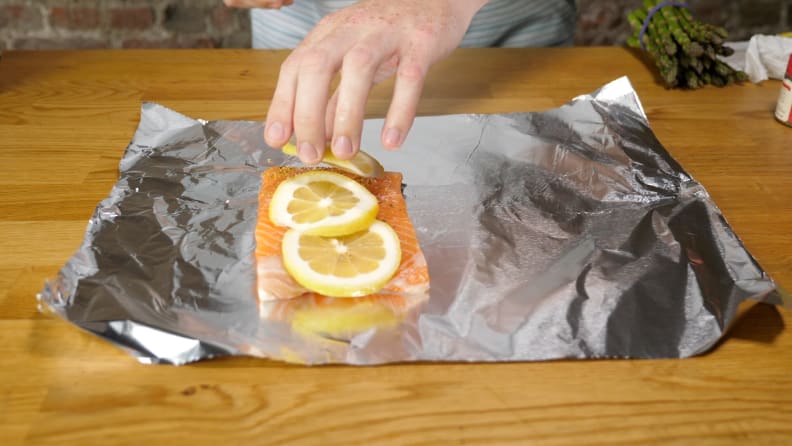
As easy as it was to buy all the groceries, preparing it may have been easier.
I put the salmon (with the skin still on) on a sheet of tin foil and seasoned it with the salt, lemon/pepper seasoning and dill seeds and topped it with a few slices of lemon. I then wrapped it tightly in the sheet of foil before wrapping another sheet tightly around it, making sure all of the cracks were folded over and no water could get inside.
For the couscous and the asparagus, I used mason jars fastened as tight as possible.
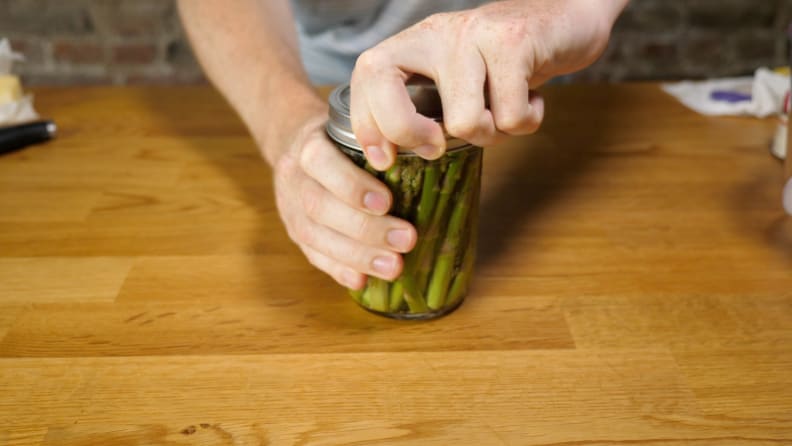
The couscous was from a box that included a packet of lemon and herb seasoning along with about 1.5 cups of chicken broth. The asparagus was cut to fit inside the jar and mixed simply with some butter, salt and one cup of water. Basically, both jars were filled to the brim with liquid.
Then they were ready to go.
The execution
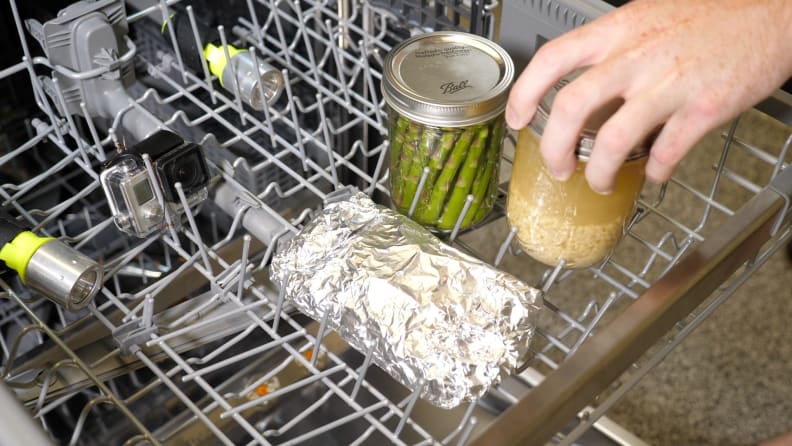
In all accounts that I looked at, one full dish cycle that takes right around an hour should do the trick.
Our dishwasher at Reviewed is newer, so one full cycle takes about three hours.
Another issue was the heat. The process is basically sous vide, which is a water bath or steam environment somewhere between about 130-140 degrees Fahrenheit.
Our dishwasher was probably not going to get up to that temperature and was going to be at about 120 degrees since it had a longer cycle.
Nonetheless we decided to give the original plan of about one hour a shot, so we put the salmon and two mason jars on the top rack and set a cycle on with plans to stop in a hour.
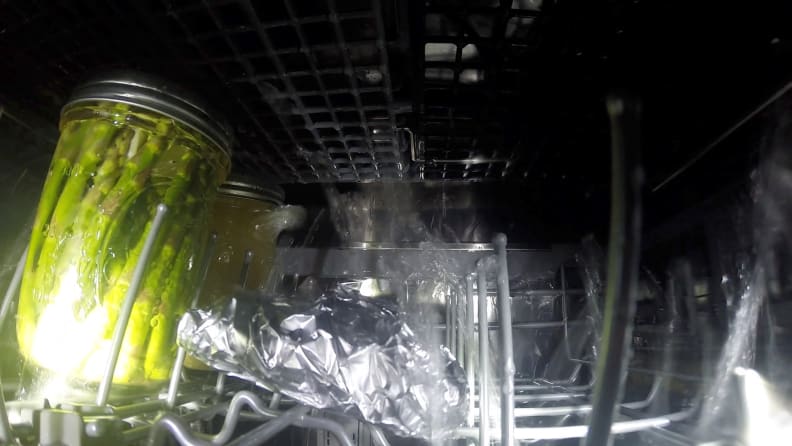
*I will note that we did not include any plates or dish soap for this experiment just to see if cooking the food was even possible without ruining anything else, but more on that later.
The results
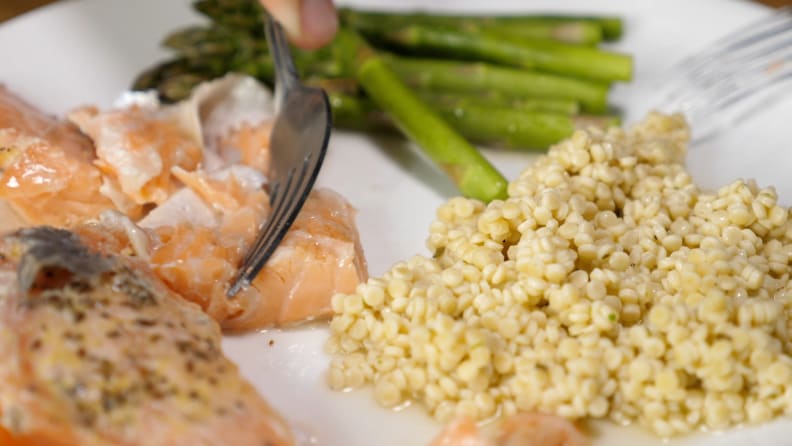
We came back after an hour of running it and stopped the cycle, pulling everything out. All parts were hot or at least warm to the touch and there was no sign of water in the foil packet or jars. Thankfully, nothing had broken either.
The only sign the salmon had been in there was a slight smell in the dishwasher which was not overpowering, just barely noticeable.
First we started with the sides. I opened the jar with the asparagus, took one out and ate it. It wasn’t fully cooked, offering a peek into the future of our experiment. It wasn’t bad or raw, but more time would’ve rendered it softer and more flavorful.
Then it was on to the couscous, which looked very much like it did when I first put it in the dishwasher, sitting on the bottom all clumped up with the broth on top. After scooping a little bit out and taking a bite, I determined that it was undercooked too.
And lastly it was on to the salmon. After unwrapping the packet, I could immediately tell it wasn’t a perfectly cooked fish. It was still a little slimy and looked more like lox that go on a bagel than salmon you’d cook for dinner.
But it was the main dish, so I was determined to try it. I and a few coworkers nibbled a few pieces and while noting it wasn’t the best cooked salmon ever, we agreed that it was edible and the flavor was good as well. (For those who might think I poisoned myself, it’s possible, but I’m sitting here 48 hours later writing this and am feeling fine at the moment so check back for updates.)
Our conclusion
After some discussion, we decided the salmon was edible, but that all of it could’ve used at least another half hour to a hour in the cycle. Basically what we agreed was that cooking dinner in the dishwasher is possible, we just didn’t do it right.
If I get a chance to try again, I absolutely would do it in my dishwasher at home which runs a quicker cycle and gets to a higher temperature than the one at our office. That may provide enough heat in a short enough period of time to produce a delicious dinner.
As for washing it with plates and soap, I don’t see why it isn’t possible as long as the jars are screwed tight and the packet is sealed completely with multiple layers of foil. There was no seeping of water anywhere and if done right, there shouldn’t be.
In short, at the moment, I am a bad dishwasher cook. But like all great chefs, I learn from doing and so the next time I go to run my dishwasher, I may toss a frozen pizza or some chicken piccata in there for a whirl as well.
